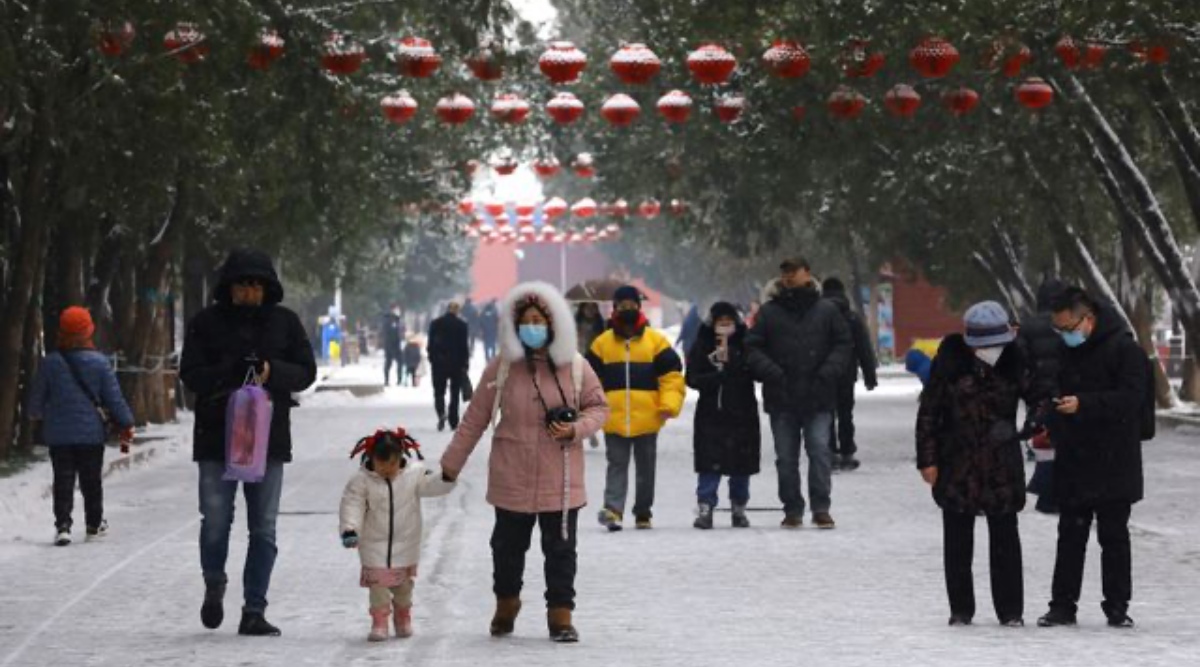 People walk in a park decorated with lanterns ahead the Chinese Lunar New Year, on a snowy day, in Beijing, China January 22, 2022. (Reuters Photo: Tingshu Wang)
People walk in a park decorated with lanterns ahead the Chinese Lunar New Year, on a snowy day, in Beijing, China January 22, 2022. (Reuters Photo: Tingshu Wang) Written by Amy Qin and Amy Chang Chien
In a glitzy Shanghai shopping district, about 40 people who happened to be at a Uniqlo store were informed that they would be spending the night there. A suspected COVID-19 case had been traced to the shop.
Elsewhere in the same city, Anna Rudashko was told to return to an office building she had visited for a meeting the day before. She spent 58 hours there with more than 200 strangers, waiting for test results.
Across China, in Shaanxi province, Zhao Xiaoqing was on a second date, visiting a man at his parents’ home, when local authorities locked down the neighborhood. She quarantined with them for nearly 30 days. (Fortunately, she said, “I got along well with his family.”)
China, which has largely kept the coronavirus at bay since 2020, is going to ever more extreme lengths to quell outbreaks that have proliferated around the country in recent weeks, and a growing number of people are finding their lives suddenly upended as a result.
At least 20 million people in three cities were under full lockdown as recently as last week, and many more cities across the country have been subjected to partial lockdowns and mass testing. During the past month, at least 30 major Chinese cities have reported locally transmitted COVID-19 cases.
The case numbers themselves are minuscule by global standards, and no COVID-19 deaths have been reported in China’s current wave. On Friday, health authorities reported a total of 23 new locally transmitted cases in five cities.
But many cases have involved the highly transmissible omicron variant, and with each passing day, the government’s dogged pursuit of “zero COVID” is looking harder to achieve. Many wonder how long it can be maintained without causing widespread, lasting disruptions to China’s economy and society.
“At this point, it’s really almost like a last-ditch, or certainly very stubborn and persistent, effort to stave off the virus,” said Dali Yang, a professor of political science at the University of Chicago. “They are really stuck.”
So far, the leadership has only doubled down on its strategy — which relies on mass testing, stringent border controls, extensive contact tracing and snap lockdowns — to extinguish nascent outbreaks.
Adding to the sense of urgency, 24 locally transmitted cases have been discovered in Beijing, where the Winter Olympics are set to open in two weeks. Several neighborhoods have been sealed off, and authorities have stepped up testing requirements for entering and leaving the capital. Officials said this week that Olympics tickets would not be sold to the public because of concerns about the virus.
Authorities have suggested that the first omicron case in Beijing may have come from a package in Canada. They have since called on people across China to use caution when opening mail from overseas. In Beijing, mail is being subjected to at least four rounds of disinfection, even though experts say the risk of contracting the virus from surfaces, especially paper or cardboard, is very low.
“It sounds unlikely to me, but I wouldn’t say it’s impossible,” said Ben Cowling, a public health researcher at the University of Hong Kong. “I would certainly suggest that the authorities keep looking in case there’s other things that could maybe explain it.”
Chinese officials previously pushed the conspiracy theory that the virus had been brought to Wuhan, where it first emerged, by U.S. military personnel. More recently, the central government blamed local officials in Xi’an for disruptions of food supplies and medical care when the city of 13 million was locked down in December.
“Beijing is finding it increasingly difficult to defend its COVID-zero policy,” said Lynette H. Ong, a professor of political science at the University of Toronto. “The costs are rising so high that they are starting to put the blame not only on local officials, but also on foreigners — it’s never the central policymakers’ fault.”
Many in China support the zero-COVID strategy, which may have saved hundreds of thousands of lives and which has allowed most people to live fairly normally during the pandemic. But the recent outbreaks have led to frustration and grumbling as more and more people have been caught up in the virus-control dragnet.
In Xi’an and other cities, officials said this week that restrictions would soon be eased because case numbers were falling. But in the longer term, there is concern that China, the last major country to hold fast to a zero-COVID strategy, may have backed itself into a corner.
While more than 80% of the population — over 1.2 billion people — has had at least two vaccine doses, most received Chinese-made vaccines, which studies have found to provide little defense against omicron infections. Experts speculate that China’s leaders may be holding out for a more effective vaccine or therapeutic, or waiting for a milder strain of the virus to emerge.
Until then, analysts say, the increasing complaints are unlikely to persuade Beijing to change its COVID-19 policy. Eurasia Group, a consultancy, recently put China’s zero-tolerance strategy at the top of its list of political risks for the year, suggesting that it would ultimately backfire for the country and roil the global economy.
“The most successful policy battling the virus has become the least,” wrote the report’s authors, Ian Bremmer and Cliff Kupchan.
This article originally appeared in The New York Times.
- The Indian Express website has been rated GREEN for its credibility and trustworthiness by Newsguard, a global service that rates news sources for their journalistic standards.

